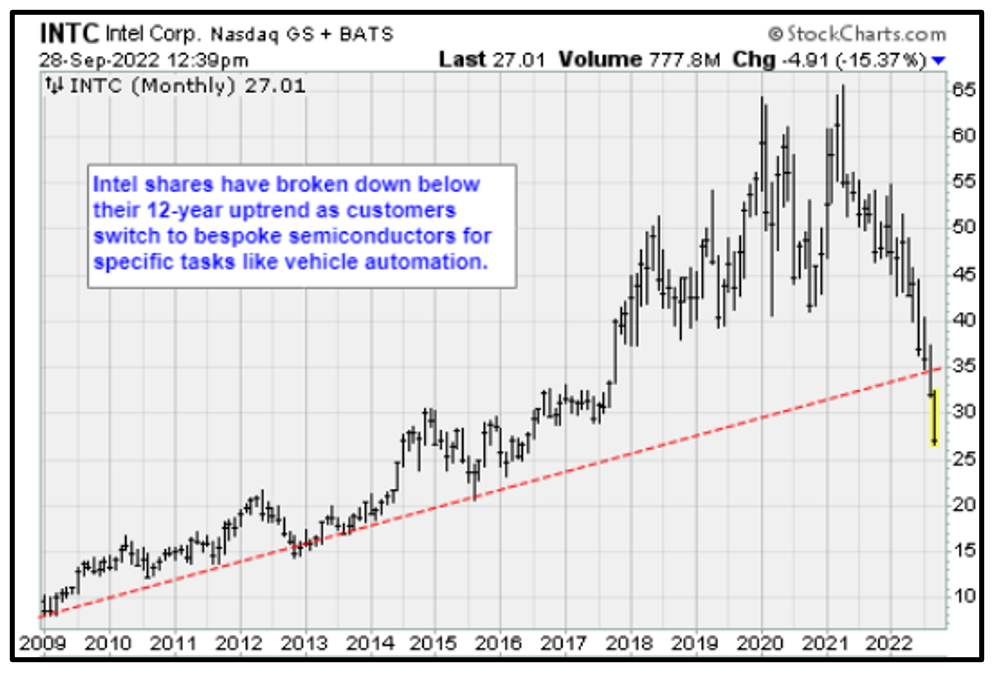Here’s one of the biggest tech trends that nobody is talking about.
It’s the race by large companies to build custom microprocessors. And it’s leaving one of the world’s biggest chipmakers in the lurch.
Last week, Cruise Automation, the automated vehicle division of General Motors (GM), made a surprise announcement. The San Francisco, California-based company is going to develop custom chips.
This is really bad news for Intel (INTC). Let me explain why ...
Semiconductors are a modern marvel. The idea that something so small can also be so powerful is mind-blowing. Until recently, processors got much smaller and even more powerful with each new generation.
That dynamic is changing.
Chips are still becoming more powerful, yet they’re not getting much smaller. It all comes down to sizing.
Processors can only get so small. To get more computing power out of silicon, chip designers are resorting to task-specific silicon.
They’re switching architecture to get it.
That’s the angle Cruise Automation is taking. The GM unit plans to have custom-made chips in 2025 for its automated vehicles.
It might not seem cost-effective to start building chips from scratch. There are off-the-shelf graphic processor units available from firms like Nvidia (NVDA). Most would draw the analogy to a car company making its own tires.
But Cruise isn’t making its chips, per se.
Rather, the company is designing, then contracting the production to a fabricator. A foundry, like Taiwan Semiconductor (TSM), is equipped with all the specialized machines required to make state-of-the-art smart silicon.
In theory, this cost could be recouped by scaling up production.
Cruise Automation CEO Kyle Vogt says the company will hit the custom chip sweet spot in 2025. That’s when production of its Origin autonomous vehicle is expected to go into production.
Origin isn’t much of a looker, however, it’s a full, personal AV with no steering wheel or pedals. GM executives believe the transition deserves new thinking.
Carmakers are trying to move away from dependency on traditional chip suppliers. The entire sector has been restrained since 2021 by ongoing chip shortages.
Ironically, those shortfalls were caused by poor planning from the carmakers themselves.
Fun fact: As the pandemic reached North America in early 2020, General Motors, Ford (F), Toyota (TM) and other firms immediately began cutting orders for chips in anticipation of a slowdown in demand.
They didn’t expect what actually happened. Consumers bought new and used cars, many of them paying top dollar for them.
And carmakers couldn’t replace them fast enough with newer models because they couldn’t get their hands on the chips that power them!
Why was it so hard to get chips? Everyone blamed breakdowns in the supply chain, but that was only half the story.
What also happened was that foundries switched production from older chips made for the automotive sector to next-generation processors required by the consumer electronics sector.
In other words, automakers moved to the back of the line. So now, they are creating their own solution.
The news that Cruise is designing chips is worrisome for Nvidia, which produces system-on-a-chip systems for the automotive market. But it has plenty of other products and business lines to attend to.
However, for Intel, this new trend is lethal.
Not only is Intel the largest producer of general-purpose chips, but its entire business model depends on mass adoption of its x86 chip architecture.
These processors are based on something called complex instruction set computing (CISC). This creates a standard instruction set that makes it easier for different hardware and software to work together.
As end-users move to task-specific chips, the larger trend is clearly moving away from CISC.
And it’s not just carmakers who are looking to ramp up production with these task-specific chips …

Click here to see full-sized image.
In fact, Apple (AAPL) moved away from CISC last year with the introduction of its custom M1 chips for laptop computers and iPads.
Apple licenses intellectual property from ARM Holdings, a British mobile tech IP firm that designs chips for mobile devices.
Nvidia bought ARM for some $40 billion back in 2020. So, it isn’t set to lose any business from companies that want to tap into ARM’s technology.
ARM chip designs use reduced instruction set computing (RISC) architecture.
Reuters reported in early September that Cruise only considered open source RISC- and ARM-based architectures for its custom chips.
The trend is obvious — and ominous — for Intel.
Shares of Intel have been under pressure since early 2021 when these trends became apparent. The company is trying to transition toward other markets, most notably national defense.
At its Intel Innovate 2022 presentation in San Jose yesterday, the company introduced Ponte Vecchio, a GPU that will be used in a new government supercomputer. Intel executives hope that processor will also help the company win market share from Nvidia in hyperscale data centers.
There’s no reason to believe that hope will be answered. Investors should steer clear of Intel shares. Its largest customers are turning away from Intel architecture. And this trend is accelerating.
As always, be sure to conduct your own due diligence beforehand.
All the best,
Jon D. Markman
P.S. If you enjoyed reading this issue, check out my paid service, Weiss Technology Portfolio. Members are currently sitting on open gains of around 267%, 254% and 153%!

